INDIAN GEOGRAPHY
WHY WERE THERE NO CYCLONES IN OCTOBER AND NOVEMBER?
THE CONTEXT: According to Indian Meteorological Department (IMD) data, “As many as seven low-pressure areas (LPA) have formed in the North Indian Ocean region since October 1, 2021 — but none of them has intensified into a cyclone. October and November constitute the peak cyclone season for India.
THE EXPLANATION:
- No cyclone formation in the rest of November would mean a first-time anomaly in the last 31 years for October and November.
- If December also remains cyclone-free, it would be the first time since 1961 that the post-monsoon season would remain without a cyclone. This has happened only five times since 1891: In 1900, 1911, 1953, 1954 and 1961.
- Initially, in the month of October 2021, the forecast for this system by the Global Forecasting System of the United States data had suggested it would intensify into a cyclone. But that did not happen. The IMD on October 18, 2021, said that cyclone formation did not happen because of unfavourable land interactions of the system.
- This is happening even though the La Nina phase of the El Nino Southern Oscillation (ENSO) phenomenon is currently prevailing. The La Nina is the cooling phase of the ENSO and is generally favourable for cyclone/hurricane/typhoon formation all over the world, including in the North Indian Ocean region.
- The North Atlantic Ocean experienced record storm and hurricane activity due to the emergence of La Nina or due to its potential emergence in the last two years. The phenomenon creates an extended region of low vertical wind shear, which is favourable for the intensification of cyclones.
- In fact, when cyclones Gulab and Shaheen had formed successively around the end of September 2021 it seemed like the cyclone season had started off. This had also come after the record-breaking formation of low-pressure areas in September that continued in October and November and caused excessive rainfall and floods in many parts of the country.
THE BACKGROUND:
What is Low Pressure and High-Pressure Area?
- A low-pressure system has lower pressure at its centre than the areas around it. Winds blow towards the low pressure, and the air rises in the atmosphere where they meet.
- A high-pressure system has higher pressure at its centre than the areas around it. Winds blow away from high pressure.
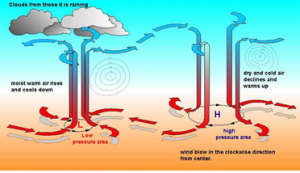
ENSO:
- El Niño–Southern Oscillation (ENSO) is an irregularly periodic variation in winds and sea surface temperatures over the tropical eastern Pacific Ocean, affecting the climate of much of the tropics and subtropics.
- The warming phase of the sea temperature is known as El Niño and the cooling phase as La Niña. The Southern Oscillation is the accompanying atmospheric component, coupled with the sea temperature change:
- El Niño is accompanied by high air surface pressure in the tropical western Pacific and La Niña with low air surface pressure there. The two periods last several months each and typically occur every few years with varying intensity per period.
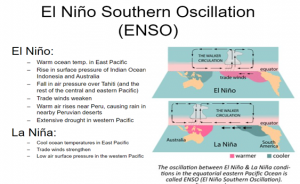
THE SHALE EXPLORATION IN RAJASTHAN
THE CONTEXT: Cairn Oil & Gas has announced that it is partnering with US-based Halliburton to start shale exploration in the Lower Barmer Hill formation, Western Rajasthan.
THE EXPLANATION:
What is shale oil? How does it differ from conventional crude oil?
- Shale oil is a substitute for conventional crude oil; however, extracting shale oil is costlier than the production of conventional crude oil both financially and in terms of its environmental impact. Deposits of oil shale occur around the world, including major deposits in the United States.
- The key difference between shale oil and conventional crude is that the former, also called ‘tight oil’, is found in smaller batches, and deeper than conventional crude deposits.
- Its extraction requires the creation of fractures in oil and gas-rich shale to release hydrocarbons through a process called hydraulic fracking.
- Russia and the US are among the largest shale oil producers in the world, with a surge in shale oil production in the US has played a key role in turning the country from an importer of crude to a net exporter in 2019
- A number of US shale exploration firms, including Halliburton, have faced litigation from citizens living in areas adjacent to shale production sites who have claimed that hydraulic fracking has contributed to groundwater contamination.
What are the benefits of shale gas?
- It notes that done properly, shale gas development can enhance energy security and the availability of energy fuels, lower natural gas prices, offer a cleaner environmental footprint than some other fossil fuels, and enable local economic development.
What is the importance of shale?
- Black shale contains organic material that can generate oil and natural gas and trap the generated oil and natural gas within its pores. Shale natural gas resources are found in shale formations that contain significant accumulations of natural gas and/or oil. These resources, or plays, are found in about 30 states.
What are the prospects of shale oil exploration in India?
- Currently, there is no large-scale commercial production of shale oil and gas in India. State-owned ONGC had, in 2013, started exploration and, by the end of FY21, assessed shale oil and gas potential in 25 nomination blocks, but has reduced investments over the past few years after only getting limited success in shale exploration efforts.
- While ONGC’s assessment found prospects of shale oil at the Cambay basin in Gujarat and the Krishna Godavari basin in Andhra Pradesh, the company concluded that “the quantity of oil flow observed in these basins” did not indicate “commerciality” and that the general characteristics of Indian shales are quite different from North American ones.
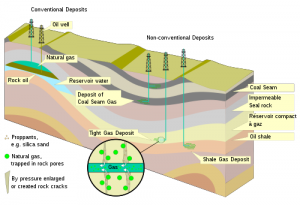
INDIAN POLITY, GOVERNANCE AND SOCIAL JUSTICE
THE REPEAL OF THREE FARM ACTS
THE CONTEXT: The Prime Minister announced the repeal of three contentious farm laws, assuring farmer groups protesting against them for the past year that the legislative process for the repeal would be completed in the upcoming Winter Session of Parliament.
THE EXPLANATION:
What are those laws?
The three laws that let to agitation by farmers across India are:
- Farmers’ Produce Trade and Commerce (Promotion and Facilitation) Act, 2020
- Essential Commodities (Amendment) Act, 2020
- Farmers (Empowerment and Protection) Agreement on Price Assurance and Farm Services Act, 2020.
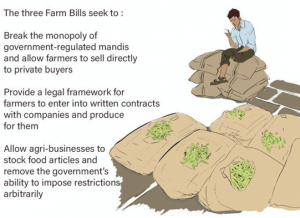
What were Farmer’s concerns?
The main concerns of farmers were that these laws will abolish the Minimum Support Price (MSP), which is guaranteed by the Centre on select crops. It will eventually leave farmers at the mercy of big corporate houses.
The Centre’s Decision of the laws
- The PM noted that the majority of farmers are small scale farmers in India. Central government tool multi-faceted approach ranging from seed technology to crop insurance schemes, in order to help these farmers.
- The three farm bills were put forward to benefit small farmers, to empower & strengthen them.
- However, the government could not convince a section of protesting farmers. In that light, the laws were repealed.
Zero Budget Natural Farming
In his address pm also noted that the central government has decided to implement Zero Budget Natural Farming and make MSP more efficient. The government will set up a committee, comprising of centres, State representatives, scientists, economists and farmers.
HOW TO REPEAL A LAW?
- Article 245 of the Indian Constitution which gives Parliament the power to make laws also gives the legislative body the power to repeal them
- The government can repeal the laws in two ways — it can either bring a Bill to repeal the three laws or promulgate an ordinance that will have to be subsequently replaced with a Bill within six months.
- Article 245 of the Constitution which gives Parliament the power to make laws also gives the legislative body the power to repeal them through the Repealing and Amending Act. The Act was first passed in 1950 when 72 Acts were repealed.
- The Act was sixth such repealing act, aimed at repealing laws, tabled by the NDA government. The ruling government already repealed 1,428 Acts during its first term.
- Generally, laws are repealed to either remove inconsistencies or after they have served their purpose. When new laws are enacted, old laws on the subject are repealed by inserting a repeal clause in the new law.
- The Repealing and Amending (Amendment) Bill will pass through the same procedure as any other Bill. It will have to clear by both Houses of Parliament and the President would give his assent to make it a law.
To learn more about Three Farm Laws, Join our Exclusive Editorial Discussion programme.
THE UNIFORM CIVIL CODE
THE CONTEXT: The Allahabad High Court has called upon the Central Government to forthwith initiate the process for its implementation. Also, stating that the Uniform Civil Code “is a necessity and mandatorily required today,”.
THE EXPLANATION:
- “A common civil code will help the cause of national integration by removing disparate loyalties to laws which have conflicting ideologies. No community is likely to bell the cat by making gratuitous concessions on this issue.
- It is the State which is charged with the duty of securing a uniform civil code for the citizens of the country (Article 44) and, it has the legislative competence to do so,” the court observed.
- HC made the observations while hearing a bunch of 17 petitions filed by inter-faith couples, seeking protection of their life, liberty and privacy guaranteed under Article 21, to live independently as man and woman without the interference of their family or others.
- Holding that “Intimacies of marriage lie within a core zone of privacy, which is inviolable”, HC said, “The absolute right of an individual to choose a life partner is not in the least affected by matters of faith.”
What is Uniform Civil Code?
The Directive Principles of State Policies (DPSP) in the Indian Constitution under Article 44 states that “The State shall endeavour to secure for citizens a uniform civil code throughout the territory of India.” Pursuant to this provision, the task of enforcing a UCC in the country was dropped in the bucket of the legislature by the Constitution makers. Being a DPSP, Article 44 is not enforceable in courts alike the fundamental rights.
The hope expressed in Article 44 of the Constitution that the State shall secure for its citizens Uniform Civil Code ought not to remain a mere hope.” This is an excerpt from a recent Allahabad High Court judgment, wherein the judiciary has once again conveyed the need of having a Uniform Civil Code (UCC) in our country. Consequently, the debate and deliberations on the need for the uniform governance of personal laws has been brought back to the table.
What are Personal Laws?
- The people of India belong to different religions and faiths. They are governed by different sets of laws in respect to matters relating to family affairs, i.e., marriage, divorce, adoption, and succession.
- We inherited this system of having different sets of personal laws for different communities from the British colonial rule, as our lawmakers at the time of Independence preferred not to interfere with religious issues. But by providing a provision for UCC in our Constitution, the constituent assembly clearly manifested its vision about uniform India.
Need of the hour:
- However, the political unwillingness and incapacity to call spade a spade has lingered on this issue for very long. The Supreme Court and various High Courts in a catena of matters have counselled the governments to enforce a UCC for more than four decades.
- The Shah Bano case (1985) dealing with maintenance to divorced Muslim women, thereafter the Jordan Diengdeh case (1985) examining the Christian Succession Act, the Sarla Mudgal case (1995) against deceitful Islamic conversion for polygamy, and the John Vallamattom case (2013) on succession rights to the recent Delhi High Court judgment, are amongst the multiple instances when the courts have strongly urged the need of having uniform civil code for the country.
ENVIRONMENT AND ECOLOGY
AMAZON DEFORESTATION
THE CONTEXT: At the U.N. climate summit in Glasgow this month, COP26, Brazil’s government brought forward a pledge to end illegal deforestation by two years to 2028, a target that would require aggressive annual reductions in the destruction.
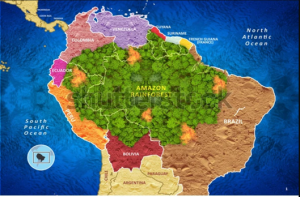
Image Courtesy: Shutterstock
THE EXPLANATION:
- Deforestation in Brazil’s Amazon rainforest rose by almost 22 per cent from August 2020 to July 2021 compared with the same period the year before, reaching the highest level in 15 years.
- The National Institute for Space Research’s Prodes monitoring system showed the Brazilian Amazon lost 13,235 square kilometres of rainforest in the 12-month reference period from 2020 August to July 2021
- Brazil was among a number of nations, including China, Russia and the United States, who vowed to end and reverse deforestation by 2030 at climate talks in Glasgow, in a landmark agreement that encompasses some 85 per cent of the world’s forests.
- Against this backdrop, Brazil’s government announced a two-year deadline to halt illegal deforestation by 2028during the United Nations Climate Summit in Glasgow this month, a goal that would need drastic yearly reductions in deforestation.
Increase in Brazil’s carbon footprint by 9.6%
- Due to extensive deforestation and warming temperatures in the region, parts of Amazon now emit more carbon than they capture. With the increase in greenhouse gas emissions and the drop of 4.1 per cent in GDP, Brazil became poorer and polluted more.
- Emissions from agriculture, which covered 577 million tons of carbon dioxide (27% of the national total) in 2020, also increased by 2.5 per cent.
- This occurred in part for a counterintuitive reason: the economic crisis reduced meat consumption, with a reduction of nearly 8 per cent in cattle slaughter. The national herd increased by about 3 million heads, which, in turn, also increased methane emissions from enteric fermentation.
Reasons for Deforestation:
- State policies that encourage economic development, such as railway and road expansion projects have led to “unintentional deforestation” in the Amazon and Central America.
- Deforestation started in the 1970s and 1980swhen large-scale forest conversion for cattle ranching and soy cultivation began.
Spread of Amazon:
- These are large tropical rainforests occupying the drainage basin of the Amazon River and its tributaries in northern South America and covering an area of 6,000,000 square km.
- Comprising about 40% of Brazil’s total area, it is bounded by the Guiana Highlands to the north, the Andes Mountains to the west, the Brazilian central plateau to the south, and the Atlantic Ocean to the east.
- The basin is shared by eight countries (Brazil, Bolivia, Peru, Ecuador, Colombia, Venezuela, Guyana and Suriname), as well as the overseas territory of French Guiana.
|
Quick Facts: PRODES is an innovative program by the Brazilian federal government to finance wastewater treatment plants while providing financial incentives to properly operate and maintain the plants. It is a type of output-based aid, as opposed to financing programs targeted only at inputs. The program was introduced in 2001 and is managed by the National Water Agency ANA. |
THE SCIENCE & TECHNOLOGY
FIRST LIGO PROJECT IN INDIA
THE CONTEXT: Hingoli Income division of Maharashtra handed around 225 hectares of land right to the authorities of the Laser Interferometer Gravitational-Wave Observatory (LIGO) project for setting up the first such facility in the country.
THE EXPLANATION:
- Aim: To study Gravitational waves arriving at earth cataclysmic events in the distant universe, and carry out experiments.
- There are currently a couple of such labs in the US – at Hanford in Washington and Livingston in Louisiana – which study the gravitational waves.
What is LIGO?
LIGO is a massive observatory to detect cosmic gravitational waves and to carry experiments. Its main objective is to make use of gravitational-wave observations in astronomical studies. This project currently operates three gravitational waves (GW) detectors. Out of three, two are at Hanford in Washington while one is at Livingston in Louisiana.
LIGO India project
- The LIGO India project was proposed with the aim of moving one advanced LIGO detector to India, from Hanford. This project is piloted by the Department of Science and Technology (DST) and the Department of Atomic Energy (DAE).
- This project in India will be coordinated and executed jointly by three Indian research institutions namely, Raja Ramanna Centre for Advanced Technology (RRCAT) in Indore, Department of Atomic Energy organisations: Institute for Plasma Research (IPR) in Gandhinagar and Inter-University Centre for Astronomy & Astrophysics (IUCAA) in Pune.
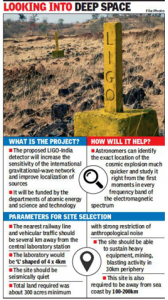
Image Courtesy: Times of India
MISCELLANEOUS
NGO PRATHAM AWARDED INDIRA GANDHI PEACE PRIZE
THE CONTEXT: Pratham, a pioneering civil society organization that is dedicated to improving the quality of education for underprivileged children in India and across the globe, has been awarded the Indira Gandhi Peace Prize 2021.
THE EXPLANATION:

Image Courtesy: Indira Gandhi Peace Prize
PRATHAM:
- Set up in 1995 by Mrs Farida Lambay and Dr Madhav Chavan in Mumbai, Pratham began its work in slum areas by setting up community-based pre-schools and by offering remedial education to students who lagged behind in their classes. Its outreach in India has now expanded to an average of one million children directly and to five million through government partnerships annually.
- “It also seeks to prevent children from dropping out of school, with special programs, especially for girls and women aimed at giving them a second chance to complete their education,”
- “The 2021 Prize is awarded for its pioneering work over more than a quarter century in seeking to ensure that every child has access to quality education, for its innovative use of digital technology to deliver education, for its programs to provide skills to young adults, for its regular evaluation of the quality of education, and for its timely response in enabling children to learn during the Covid-19 – related school closures,”.
ASER:
- The foundation’s Annual Status of Education Report (ASER), with the latest one being released in November 2021, serves as a model to assess educational outcomes and learning deficiencies across 14 countries on three continents.
- ASER 2021 is based on a survey conducted by the education foundation in 25 states and Union territories. This year, the survey, which covered a total of 76,706 households and 75,234 children between the age group of five to 16 years, said that between 2018 and 2021, government schools saw an increase in the proportion of enrolled students for all ages and grades.
INDIRA GANDHI PRIZE FOR PEACE:
- The Indira Gandhi Prize for Peace, Disarmament and Development was instituted in the memory of the former prime minister by a trust in her name in 1986. It consists of a monetary award of ₹25 lakh along with a citation. The jury is chaired by former Chief Justice of India, Justice T.S. Thakur.
PRELIMS PRACTICE QUESTIONS
Which Article of the Constitution of India safeguards one’s right to marry the person of one’s choice? (UPSC Prelims 2019)
a) Article 19
b) Article 21
c) Article 25
d) Article 29
ANSWER FOR NOVEMBER 19th, 2021 PRELIMS PRACTICE QUESTIONS
Answer: C
Explanation:
- Statement 1 is incorrect: The law considers children as those individuals below the age of 18 years of age.
- Statement 2 is incorrect: The act is gender-neutral.
- Statement 3 is correct: The case under the provision of this law is disposed of within one year from the date of reporting of the offence.

